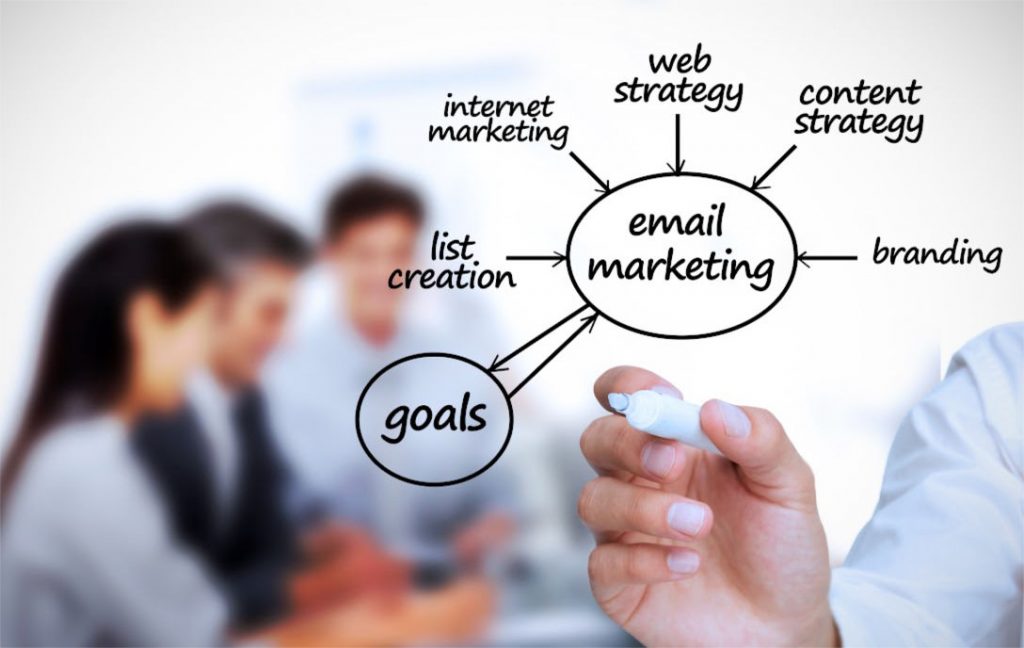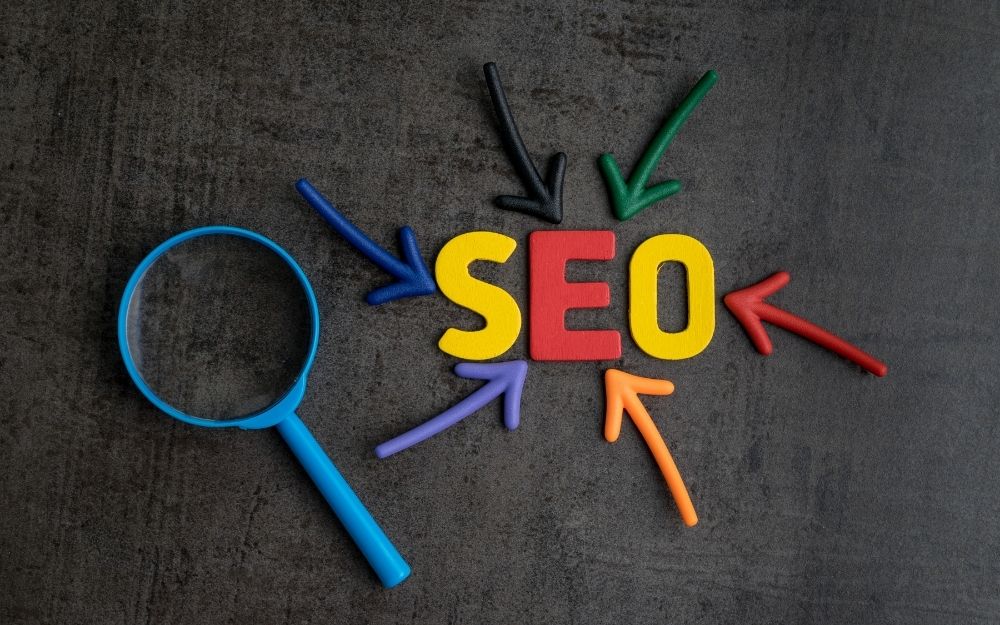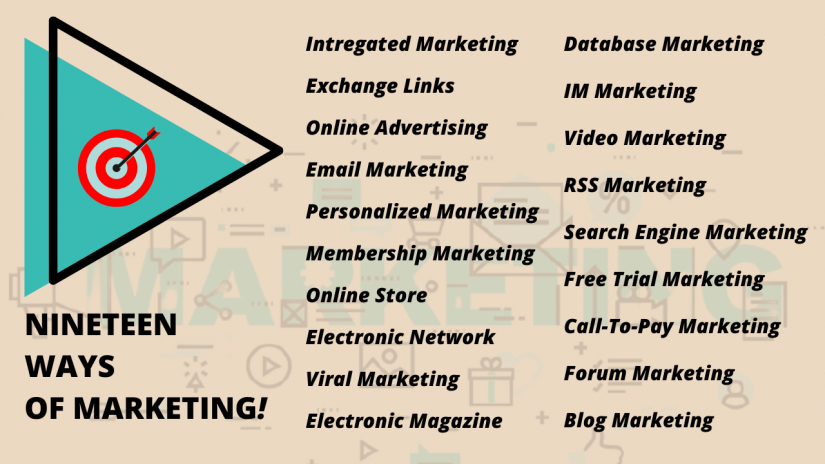The world is not as simple as it used to be until a few years ago. With the rapid advancements in technology, business environments have also changed drastically to become much more complex and diverse than ever before. Consequently various types of marketing styles emerged to serve the changing needs of the modern business environment. Let’s discuss them one by one.
Table of Contents
- 1) Electronic network communication:
- 2) Integrated marketing:
- 3) Promotion Using Exchange links:
- 4) Online Advertising:
- 5) Email Marketing:
- 6) Personalized Marketing:
- 7) Membership Marketing:
- 8) Online Store:
- 9) Viral Marketing:
- 10) Call-To-Pay Marketing:
- 11) Forum Marketing:
- 12) Blog Marketing:
- 13) Electronic Magazine Marketing:
- 14) Database Marketing:
- 15) IM Marketing:
- 16) Search Engine Marketing:
- 17) Video Marketing:
- 18) RSS Marketing:
- 19) Free Trial Marketing:
1) Electronic network communication:
The advent of the information age allows people to have more and faster ways to access information, providing faster and better communication for companies that helps them re-innovate their brand communication networks. Electronic networks are much superior to any other communication media in terms of both reach and effectiveness. Anyone can enter the online world at any time and anywhere. It can significantly shorten the distance between companies and consumers, allowing companies to provide more detailed, vivid, accurate, and fast brand positioning information. The network has the characteristics of low cost along with having predictability, interactivity, real-time, extensiveness, etc., which are not available in other media. It allows brand communication to get more responses from consumers and reach a broader range of consumers, thus opening up a new way for brand communication. This new online publicity method is easily favoured by consumers and has a significant effect on the brand’s development.
2) Integrated marketing:

Integrated marketing is a systematic strategy of combining all the organization’s communications aimed at a specific audience. It coordinates all elements of a brand’s marketing, including:
- Paid media (such as print ads, direct mail, and internet display and programmatic advertising)
- Media that has been earned (e.g., organic search traffic obtained by content marketing)
- Owned media (such as social media, website, customer service, and direct messaging via email and mobile).
The aim is to achieve consistent messaging that results in a unified and seamless experience for customers throughout their customer lifecycle. When communication is coordinated across channels, it results in increased brand awareness, familiarity, favourable ratings, and buy intentions of customers are considerably greater than when messages are not coordinated.
3) Promotion Using Exchange links:
Exchange links are a simple form of cooperation between websites. It involves placing the other website’s logo or name on ones website and setting the hyperlink of the other website so that users can be directed to the other website. The role of exchange links mainly includes gaining more traffic, getting advantages in search engine rankings and increasing a website’s credibility through the recommendation of cooperative websites. While entering exchange links agreements, attention should be paid to the quality of the other party’s website. As if your website redirects to a lot of low credibility or useless websites, your own reputation may go down.
4) Online Advertising:
Among all network marketing methods related to brand promotion, online advertising plays the most direct role. Standard signs advertising (e.g., banners) used to be the mainstream online advertising till the previous decade. In the present decade, advertising has gone through vigorous innovations and the new advertising have largely overcome the standard banners advertising. Banners have weaknesses such as the limited amount of information, low reach and low interactivity, while modern internet based advertising covers all these shortcomings, so they have a relatively high click-through rate.
5) Email Marketing:

Email marketing includes sending advertisements and other communication directly to the customers through email. The prerequisite for developing Email marketing is to have the Email addresses of potential users. These addresses can be collected and sorted out by the company from a user and from a potential user data or use third-party potential user resources. However it is better to ask customers if they want to receive those emails or not, or otherwise give them an option to unsubscribe from the mailing list. Sending unnecessary emails may annoy customers and your brand reputation may go down in their view. On the other hand, sending emails to the customers who are agreed has multiple advantages like enhancing the relationship with customers, improving brand loyalty, etc. This is because the customers who agreed to receive your emails are those who are interested in you and you must put special efforts to keep them happy.
6) Personalized Marketing:
In this type of marketing, users customize the information content they are interested in, choose their favorite products or topics, and set the receiving method and receiving time of information according to their needs. Personalized services have apparent effects in improving customer relationships, cultivating customer loyalty, and increasing online sales.
7) Membership Marketing:
Membership marketing has been proven to be a useful marketing tool for e-commerce websites. Many foreign online retail websites have implemented membership plans, covering almost all industries. Generally speaking, domestic membership marketing is still in the early stages of development, but it has been seen that e-commerce companies have shown strong interest and healthy development momentum.
8) Online Store:
It is a relatively simple form of e-commerce built on an e-commerce platform provided by a third party and operated by the merchants themselves, just like renting a venue in a large shopping mall to open a merchant’s speciality store. In addition to the essential function of directly selling products through the Internet, online stores are also an effective means of online marketing. From the perspective of corporate marketing strategies and customers, the role of online stores is mainly manifested in two aspects: on one hand, online stores provide convenient conditions for companies to expand online sales channels; and on the other, they are established on well-known e-commerce platforms which increases the trust of customers.
9) Viral Marketing:

Viral marketing is not carried out by spreading viruses. Still, through the user’s word-of-mouth publicity network, the information spreads and spreads like a virus, using rapid replication to reach thousands and millions of audiences. You can easily circulate favourable stories on the internet and propel them a little to go viral.
10) Call-To-Pay Marketing:
Pay according to the number of valid calls received from customers. The English “PayPerCall” is a new advertising billing model that has emerged in Europe and the United States. It realizes no charge for planning, no charge for display, no charge for clicks, and only advertisers receive. Advertisers are charged after the customer has made a call, or in other words, advertisers have to pay only when the advertisement has worked well in attracting a customer.
11) Forum Marketing:
Forum marketing focuses on certain topics so that members who have joined the forum may obtain more in-depth information on those topics. The conversation can take place anywhere the participants are if they have something in common, such as a shared background, experience, or even culture. Forum marketing is a platform for companies to use forums as a network communication platform to publish information about their products and services through text, pictures, and videos. Let the target customers have a deeper understanding of the company’s products and services.
12) Blog Marketing:

Blog marketing is a marketing activity in which bloggers and viewers are contacted through blog sites or blog forums. The personal knowledge, interests, and life experience of the bloggers are used to spread product information. Compared with traditional marketing, blog marketing has the characteristics of more precise goals, lower marketing costs compared with traditional marketing methods. It is an interactive form of advertising that draws strength from the personal experience of the bloggers and the trust of the readers in the blogger.
13) Electronic Magazine Marketing:
E-magazine marketing: is a marketing method that uses e-magazines as a carrier. E-magazines are an excellent form of media expression. It combines the characteristics of both the print media and the internet and incorporates the mutual dynamics of images, text, and sound. Combining them to present the readers with a delightful way of reading what they like and see related advertisements at the same time.
14) Database Marketing:
This is a marketing method in which companies collect and accumulate member (user or consumer) information after analysis and screening. It includes targeted use of emails, text messages, phone calls, letters, and other methods to conduct customer in-depth analysis and relationship maintenance. Database marketing is a brand new sales method that aims to establish a one-to-one interactive communication relationship with customers and rely on a vast customer information database for long-term promotional activities. It is a dynamic database management system that covers existing customers and potential customers and can be updated at any time. The core of database marketing is data mining. The database marketing in network marketing is more based on the internet as a platform for marketing activities.
15) IM Marketing:
IM marketing also called instant messaging marketing, is a means for companies to help companies promote products and brands through instant tools. There are mainly two situations commonly used:
Type#1: The first type is online communication. Small and medium-sized enterprises usually have instant messaging online when they establish an online store or corporate website. Potential customers interested in products or services will naturally take the initiative to contact online businesses.
Type #2: The second type is advertising. Small and medium-sized enterprises can use IM marketing communication tools to release some product information and promotional information, or they can post some expressions that netizens love to hear through pictures, and at the same time, add signs that the company wants to promote.
16) Search Engine Marketing:

Search Engine Marketing involves promoting your products through your website by enhancing the reach of your website through search engine optimization. A marketer uses search engines as a platform to adjust the ranking of web pages on search results pages to bring traffic to the website as a means of marketing activities aimed at search engine users. To put it simply, search engine marketing is network marketing based on search engine platforms. It uses people’s dependence on search engines and their habits to use search engines to look for information. It aims at targeting customers as much as possible when people retrieve information.
Also read: All About Marketing Through Website And SEO
17) Video Marketing:
Video marketing refers to companies’ marketing methods to put various short video clips on the Internet in various forms to achieve specific publicity purposes. Online video advertising is similar to TV video clips, but the platform is on the Internet. The combination of “video” and “Internet” gives this innovative marketing the advantages of both.
18) RSS Marketing:
RSS is an acronym for Really Simple Syndication. It’s a new way for marketers to produce and distribute information, such as news headlines, newsletters, blog posts, and affiliate advertising. It’s a syndication format for web content. We may promote the RSS feed in a variety of ways. All of your web content and marketing communications are distributed to subscribers via RSS. There are no issues of spam filters or blacklists to be concerned about.
19) Free Trial Marketing:
Free trial marketing is a very effective marketing method. Through a free trial of a company’s new products, it can increase brand awareness and achieve the effect of word-of-mouth marketing. If the free trial users like your product, they may become returning customers in the later period.

